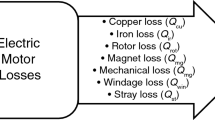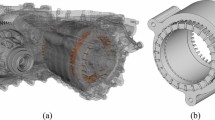Abstract
For the permanent magnet guideway (PMG) of the high temperature superconducting (HTS) magnetic levitation (Maglev) vehicle system, there should be many air gaps between two adjacent permanent magnets by connecting, which may fluctuate magnetic field in the propulsion direction of the vehicle. A three-dimensional (3D) model of a PMG is built up using FLUX 3D software. The magnetic field density of an NdFeB PMG is measured and simulated by 3D and 2D models. Comparison among their results indicate that the simulation results of the 3D model agree better with the measuring results than that of the 2D model, and thus the 3D model is more suitable to describe the PMG. By the model, the influence of the air gap on the uneven of the magnetic field density in the propulsion direction is studied. It is found that the magnetic field 15 mm above the PMG is roughly even in the propulsion direction, although the magnetic field at 2 mm is not even. Since the working height 15 mm is a sensitivity parameter for the onboard high temperature superconductor (HTSC), the levitation force at working height 15 mm above PMG is measured, which indicates that the influence of the air gap on the levitation force is very small so as to be ignored in the quasi-static state.
Similar content being viewed by others
References
Brandt, E.H.: Appl. Phys. Lett. 53, 1554 (1988)
Hull, J.R.: Supercond. Sci. Technol. 13, R-1 (2000)
Moon, F.C.: Superconducting Levitation. Wiley, New York (1994)
Bakke, P.: [Online]: http://www.energetics.com/meetings/wire05/pdfs/session8/session8d.pdf (19–20 January 2005)
Jiasu, W., Suyu, W., Youwen, Z., Haiyu, H., et al.: Physica C 378–381, 809–814 (2002)
Shultz, L., de Haas, O., Verges, P., Beyer, C., Rohlig, S., Olisen, H., Kuhn, L., Berger, D., Noteboom, U., Funk, U.: IEEE Trans. Appl. Supercond. 15, 2031–2035 (2005)
Putman, P.T., Zhou, Y.X., Fang, H., Klawitter, A., Salama, K.: Supercond. Sci. Technol. 18, S6–S9 (2005)
Wang, S.Y., Wang, J.S., Ren, Z.Y., et al.: Physica C 386, 531–535 (2003)
You, R.Z., Su, W.J. et al.: Chin. J. Low Temp. Phys. 25(2)
Okano, M., Iwamoto, T., Senokuchi, M. et al.: IEEE Trans. Appl. Supercond. 14(2) (2004)
Wang, S.Y., Wang, J.S., Deng, C.Y. et al.: Presented at applied superconductivity conference, paper No. 2LG06, 2006
Author information
Authors and Affiliations
Corresponding author
Rights and permissions
About this article
Cite this article
Liu, M., Wang, S., Wang, J. et al. Influence of the Air Gap between Adjacent Permanent Magnets on the Performance of NdFeB Guideway for HTS Maglev System. J Supercond Nov Magn 21, 431–435 (2008). https://doi.org/10.1007/s10948-008-0373-5
Received:
Accepted:
Published:
Issue Date:
DOI: https://doi.org/10.1007/s10948-008-0373-5




